Snoman R. Dance Music Manual: Tools, Toys, and Techniques
Подождите немного. Документ загружается.


PART 2
Dance Genres
314
Portishead and Massive Attack the style often exhibited a slow, almost depress-
ing feel. Although these three acts did not necessarily aim to create music that
was particularly dark, it just so happened that the brooding attitude of the music
often oozed a dismal feeling. Part of this may have been attributed to the fact
that they had all worked in the same circle. Massive Attack and Tricky originally
produced music together under the moniker ‘ The Wild Bunch, ’ and Portishead’s
founder Geoff Burrow aided Massive Attack in producing Blue Lines .
On the back of this relatively new genre, more trip-hop artists began to emerge,
each putting their own distinctive twist on the music. Artists such as Red
Snapper, Howie B, Baby Fox, Lamb, Sneaker Pimps and the Brand New Heavies
mutated the genre by mixing it with break beat, ambience, house and acid jazz.
The vocals became more upbeat and lively to encapsulate a wider audience,
resulting in trip-hop being associated with more energetic music rather than
the dark and gloomy vibe. Indeed, because trip-hop is often associated with a
dark brooding atmosphere, many artists do not appreciate being placed under
the trip-hop tag and will describe their music as ‘Illbient’, ‘Ambient hip-hop ’,
‘ British hip-hop ’ or ‘Jazz hop ’.
MUSICAL ANALYSIS
Actually defi ning trip-hop for musical analysis is diffi cult because, as men-
tioned, most artists will fl atly deny that they produce this particular style of
music. In fact, only Massive Attack, Portishead and Tricky don’t seem to mind
being labelled as producing the genre. Nevertheless, it can be roughly summa-
rized that trip-hop is commonly produced using an eclectic mix of acoustic and
electronic instruments, combining ideas from R ‘n’ B, hip-hop, dub, ambient,
industrial and jazz. This means that it often features instruments such as acous-
tic pianos, Rhodes pianos, upright basses, clavinets, horns and fl utes, along
with electric and acoustic guitars. Principally, these are combined to produce
an often nostalgic or dark ambience which is helped along further with haunt-
ing vocals and samples taken from vintage radio and fi lms.
On the subject of samples, in keeping with its original roots of hip-hop many
of the instrumental riffs, melodies and drums are commonly sampled for old
records. It’s this approach that is often accredited to the creation of ‘lo-fi’ since
these samples are not respectively ‘cleaned up ’ and are often left dirty and gritty
even to the point that the vinyl crackle is left evident in the background of the
music. This approach has meant that even if the sounds are recorded from a
live instrumentalist (which is progressively becoming more common), it’s
quite usual to dirty them up a little (as mentioned, Portishead in particular are
renowned for recording all their instruments to old analogue tapes before sub-
mitting them to digital media for editing and mixing). This helps to retain the
‘ old’ feel that is often crucial to the production of the genre.
When it comes to the equipment used by the artists, many of them are particu-
larly nonchalant about what’s used, but Portishead are notoriously cagey about
both their production techniques and equipment. Nevertheless, producing

Trip-Hop
CHAPTER 16
315
this style of music does require you to use the ‘right’ type of instrumentation
and effects to produce the atypical feel of the genre. The fi rst of these is access
to a large collection of old vinyl records, particularly jazz, a decent record
player and a sampler. Due to legal reasons it’s immoral for me to suggest that
you should rely on sampling from records to produce music but it is impor-
tant to note that much of this genre relies so much on sampling that many
record companies now ask which records have been sampled when the music
is submitted.
Of course, these samples are very rarely used ‘as is ’ and it’s common to manipu-
late them in wave editors, or more specifi cally, sample slicing programmes such
as Wavesurgeon. This is predominantly the case with the drum rhythms as these,
more than any other aspect, are commonly sampled to help attain the feel of the
genre. Generally, it’s the break beat of the record that is sampled (i.e. the mid-
dle eight of the original record where the drummer goes off on one for a couple
of bars) which is then cut up, rearranged. If required, the tempo is reduced or
increased to between 100 and 120 BPM to form the basis of the requisite relaxed
feel. That said, it should be noted that while sampling and rearranging breaks is
the most common form of creating a loop, it is not the only method employed.
The rhythms can also be programmed in drum machines or sequencers. It all
depends on the artists working on the project and their methodology, so we’ll
examine the principles behind generating new grooves with both applications.
The most popular process, as touched upon, is to sample breakbeats from old
jazz records which can then be sliced, diced and rearranged sample slicing pro-
grammes, such as Wavesurgeon or they can be sliced and have each individ-
ual sample mapped to a key in the sampler to be played live from a keyboard.
Although sampling from vinyl will often produce quite dirty timbres, it’s often the
case that they’re not fi lthy enough, so when fi rst sampling the breakbeats it’s advis-
able to sample at a much lower rate than CD quality (most trip-hop musicians use
the E-Mu SP1200 or the Casio FZ due to the poor sampling quality). The typical
resolution is 12-bit 22 kHz, but reducing the bit rate further to 8 bit may provide
even better results, depending on the source. Alternatively, when using sample CDs
in Wav or AIFF format you can often lower the rate in most wave editors.
While sampling at a lower quality will grit up the beats to a good degree, it’s
worth manipulating the sounds further using EQ, fi lters, transient designers
and distortion to acquire the sounds you need. The use of these effects is purely
down to experimentation, but it’s often worth inserting a compressor directly
after them so you can go as mad as you like without the fear of overloading the
mixers inputs/outputs.
Of course, sampling beats from old records brings up numerous copyright
issues, so it’s sometimes worthwhile programming your own drum timbres
and contorting them with effects into sounds that are more suited to the genre.
These timbres can be sourced from almost anywhere, including the jazz kit from
GM modules or more commonly a mix of the Roland TR808, TR909 and the
E-Mu Drumulator. As always, however, you can program all these timbres in any

PART 2
Dance Genres
316
capable synthesizer and then experiment with the various parameters on offer
before applying effects to construct the atypical ‘trip-hop’ kit.
The trip-hop kick drum can range from being quite low and boomy to quite
bright and snappy: it depends on how you want the loop to appear. As a good
starting point, the kick can be produced with a 100 Hz sine wave that’s modu-
lated with a positive pitch envelope set to an immediate attack and a medium
decay. If you need it to be a little tighter, then reduce the decay and place a small
transient click at the beginning of the waveform. A good way to produce this
click is to sample any of the GM drum kicks and, using a wave editor, remove
the tail end of the sample before dropping it over the top of the programmed
kick. Alternatively, it can be produced using a square wave with an immediate
attack and very short release for the amp envelope. Once programmed, this can
be laid over the top of the sine wave and can be tuned up or down to produce
the basic timbre. It’s important to note here that you’re only after a fairly basic
kick drum timbre at this point, since after the rhythm has been programmed it
will be affected further to produce the fi nished article.
Moving onto the snares, these tend to be quite bright and snappy, which
is often accomplished by fi ltering and augmenting the timbre with small
amounts of controlled distortion, but the basic sound can be produced with
nothing more than a triangle wave mixed with a white noise waveform. An
amp envelope set to an immediate attack with no sustain or release and a very
short decay is used to shape the triangle, while a second amp envelope is used
to shape the noise waveform. This uses the same attack, sustain and release
parameters but, by setting the decay a little longer than the triangle, the noise
will ring out beyond the triangle and gives you independent control over the
triangle and noise to create the timbre you’re after. As the fi nal icing on the
cake, a band-pass fi lter can be used to remove the low-end frequencies along
with some of the high-end noise to produce a typical trip-hop snare. On the
other hand, on occasion once the snares have been created, the tail is removed
so that only the initial transient is left, producing a click rather than a thwack.
Massive Attack and Portishead have both used this technique.
This same sample cutting technique is also commonly employed on the high hats
to produce a timbre that ticks rather than hisses. In fact, some trip-hop tracks have
actually used samples of the ticking of a clock to produce the timbre. These can of
course be synthesized quite easily using any synth. Although ring modulation does
produce better hi-hat timbres, for trip-hop white noise is perfectly suffi cient. To
create this simply select white noise as an oscillator and set the fi lter envelope to
a fast attack, sustain and release with a medium to short decay. Once this is done,
set the fi lter to a high pass and use it to roll-off any frequencies that are too low to
create a high hat. Once this basic timbre is down, lengthening the decay param-
eter can create open hi-hats, and shortening it will produce closed hats. By set-
ting this very short you can also produce the typical ticking timbre. Alternatively,
if samples are used it’s prudent to either use the amplifi er’s decay envelope in the
sampler or use a wave editor to remove the subsequent tail of the hats.
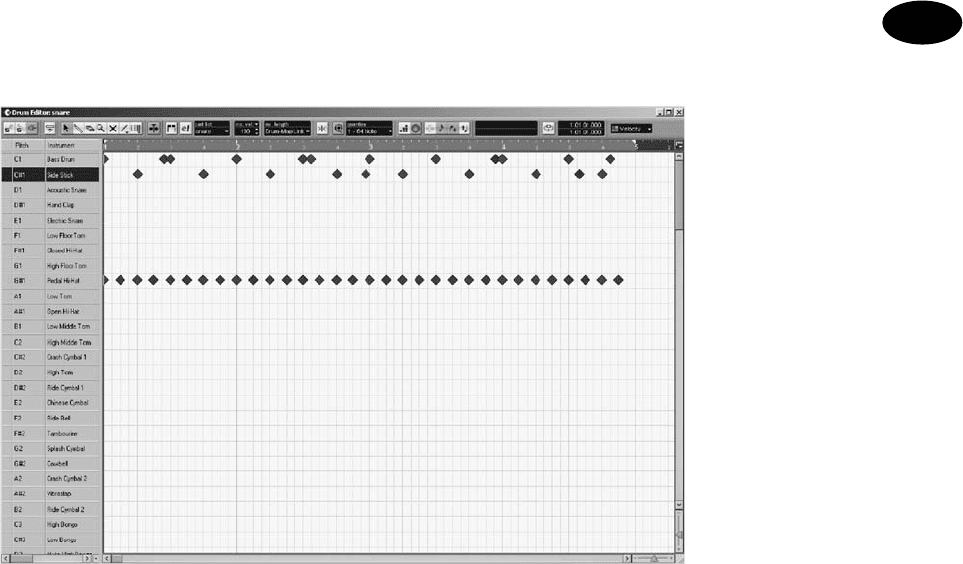
Trip-Hop
CHAPTER 16
317
Whether the grooves are sampled or programmed, the most fundamental
aspect of creating the typical groove lies with the pattern. All trip-hop derives
its feel from hip-hop and jazz and so relies on a relatively sparse drum arrange-
ment with the laid-back feel produced by the interplay between the kick and
the snare. As a consequence, the often-used kick/snare/kick/snare pattern is
often (but not always) avoided. Generally speaking they commonly feature
more rhythmic kick patterns, which are augmented with the occasional snare.
Of course , closed hi-hats, ride cymbals and pedal hi-hats are also employed,
along with the occasional open hat or crash cymbal, all of which add some
syncopation and steadiness to the rhythm ( Figure 16.1 ).
As mentioned, snares are not always used in the production of trip-hop and
any ‘clicky’ percussive timbre can be used in its place. What is important, how-
ever, is that the entire loop is quite reserved in terms of instruments and pat-
terns. In many cases these are kept incredibly simple to allow room for the
delicate vocals, chords and lead instruments to play over. Also, it’s important to
bear in mind that many of these elements will sit just off the beat rather than
strictly quantized on it, so that the rhythm appears to be played live. In fact, the
real key to producing these rhythms is to keep the drums as simple as possible
and play them live from a workstation or keyboard, and then use functions
such as iterative quantize to prevent the pattern from becoming too wayward.
Velocity also plays a large role in the creation of the rhythm to keep the real-
ism. The most common method of producing a live beat is to implement the
strong –weak–medium–weak syncopation on the kick drums, although the actual
velocities may stray wildly from this guideline depending on the sound you
FIGURE 16.1
A trip-hop rhythm
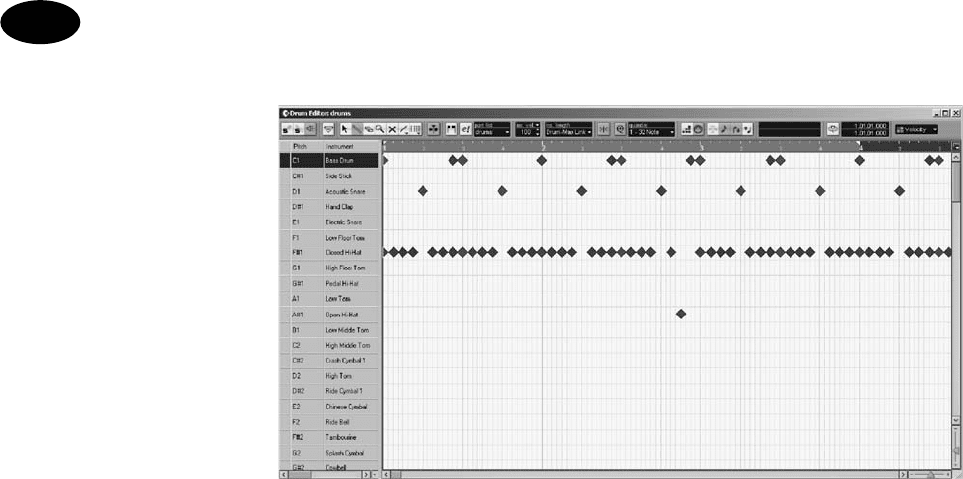
PART 2
Dance Genres
318
wish to achieve. The snares too are often subjected to different velocities, with
the fi rst and fi nal snares using the highest values and those in between using a
mixture of different values ( Figure 16.2 ).
On top of this, many trip-hop tracks also often employ small snare rolls in the
rhythms to add to the fl ow of the groove. These are often played monophoni-
cally, however, and very close together so that the consecutive snares remove
the tails of those that precede them. This can be accomplished by setting the
synth or sampler to monophonic operation. Alternatively, they can be pro-
grammed in audio by physically cutting off the tails of the snares and position-
ing them one after the other. For added interest these can also be subjected to
pitch bend so that the snares roll downwards in pitch. This downwards roll is
often preferred to pitching upwards since a movement down the scale tends to
sound less uplifting ( Figure 16.3 ).
As always, these are only generalizations and are fully open to further experi-
mentation. Indeed, after programming a typical loop it’s quite usual to use a
series of effects and processors to seriously grunge up the audio. The fi rst of
these techniques involves speeding up the tempo of the rhythm from the usual
100 –120 BPM to 150 or 160 BPM. This loop is then sampled at a low-bit rate,
typically 12- or 8-bit, set across the keyrange of the sampler and then played
in the lower registers so that not only does the tempo slow down but the pitch
also becomes signifi cantly lower. Alternatively, the loop could be sampled
at the original tempo and then time-stretched numerous times by extreme
amounts each time. The more this is applied, the more the loop will begin to
degrade as each subsequent time-stretching algorithm will impart some degra-
dation into the audio.
Another technique involves playing the loop through a speaker system and
miking up the speakers using a poor-quality microphone and pre-amp. This
FIGURE 16.2
A trip-hop rhythm
using snares
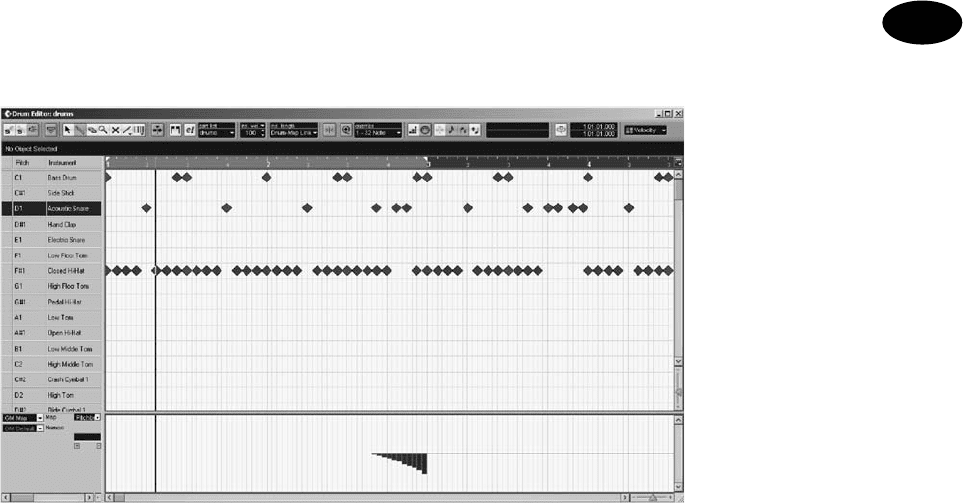
Trip-Hop
CHAPTER 16
319
can often add suffi cient dirt to anything that is recorded, and you can experi-
ment by moving the placement of the microphone. You may also capture small
amounts of incidental sounds such as traffi c outside using this method which
may actually enhance the overall lo-fi effect. Similarly, recording the loop down
to an old (and hopefully knackered) analogue tape machine will introduce
adequate hiss and sound degradation that can then be re-recorded into the
audio editor. So long as any of these techniques are followed by a compressor,
you should feel free to experiment wildly.
On the subject of compression, trip-hop drum loops benefi t hugely from incred-
ibly heavy compression. In many instances this contributes a great deal to the
overall sound. Although there are no defi nitive settings – depends on the loop
and the timbres being used – a good starting point is to set a very low threshold
with a ratio of approximately 10:1. Once these are set, experiment with the attack
and release settings. While generally the idea is not to create a loop that pumps,
you need to compress the loop as hard as possible by trying out various settings
so that the loop becomes as ‘heavy ’ as possible.
With the basis for the drums laid down, it’s quite usual to follow these with the
chords or leads rather than with the bass. Since trip-hop draws its inspiration for
bass lines from dub (and in some cases hip-hop), they remain relatively simple
and only act as a basic underpinning for the chords and lead to interweave with. As
a consequence, it’s usually prudent to lay down the chord structure fi rst, followed
by the leads and vocals before fi nally developing the bass to sit around them.
Generally speaking the chords and most of the overlaying instruments are usu-
ally written in a minor rather than major key since, as we’ve already touched
upon in music theory, these provide a more serious and sometimes dark feel
to the music. Naturally, the actual chord structure is up to your own artistic
FIGURE 16.3
A typical trip-hop snare
roll augmented with
pitch bend

PART 2
Dance Genres
320
license, but generally chord structure does not involve large amounts of move-
ment through the pitch range and tends to stay rather static, using simple inver-
sions rather than jumping manically from one key to another. A good starting
point for these is to write a chord in A minor and then create some inversions
based around this. That said, it is often worth moving between consonant and
dissonant chords to produce a cacophonous feel to the music. Portamento
is also useful here, so experiment by overlapping notes slightly and using
it so that the pitch sweeps up and down between the notes of the consecu-
tive chords. This will invariably produce more laid-back results than a chord
sequence that triggers suddenly on each new note.
The timbres used for the chords can range from samples of a real string section
(ensure that you write these in the right key – violins, for example, cannot play
any lower than the G below middle C!) to synthesized pads that are swept with
a low- or high-pass fi lter. If you decide to take the latter approach, the timbre to
use is down to your discretion, but we can nonetheless look at the construction
of a basic pad which can then be contorted further to suit your music.
Typically, the pad in trip-hop is fairly rich in harmonics, allowing it to be swept
with a low-pass fi lter if that is required to add some weight, or alternatively
swept with a high-pass or band-pass fi lter if the idea is to produce a ghostly
backing. A good starting point for this is to use either two sawtooth waveforms
or a sawtooth and a pulse wave. Detune one oscillator from the other by 5 or
7 cents and then set the amp envelope to use a fast attack with a short decay,
medium sustain and a fast release. If you want to sweep the fi lter (keep in mind
that a swept low-pass fi lter will use a proportionate amount of frequencies in
the mix) then set the fi lter’s envelope to a slow attack and decay with no sus-
tain or release and set this to positively modulate the fi lter’s cut-off. Otherwise,
use a high-pass or band-pass fi lter or, to keep the timbre static (at this point),
use the same settings as the amp envelope with a slightly longer decay on the
fi lter and set the fi lter key follow to positively track the pitch. If the pad is not
being swept and consists of long sustained notes in the chord structure then it’s
prudent to add some movement to the timbre by using an LFO to augment the
pulse width or the resonance of the fi lter. The waveform, rate and depth to use
on the LFO will obviously depend on what you wish to achieve, but generally a
square, triangle or sine wave will produce the most ‘natural’ results.
Although any effects should generally be avoided this early since they tend to
occupy a signifi cant amount of space within a mix, if the pad is to play a large
role in the music then it may be worth applying effects now to produce the fi n-
ished timbre. Typical effects for this include heavy chorus or light reverb, but it’s
worth experimenting with other effects to produce the results you want. One of
the classic effects to use on a pad in trip-hop is a vocoder. If your employ the
tracks drum loop as a modulator and use the pad as a carrier wave, the drums
will impose a new character onto the pad, forcing it to fl ow in and out of the
mix with the drums. Alternatively, you can make a copy of the drum track,
move it forward in time and use this to modulate the pad through the vocoder.

Trip-Hop
CHAPTER 16
321
This results in the pad ‘pulsing’ between the kicks of the original loop creating
a forced syncopation. And of course, as a fi nal stage, the pad will need to be
sampled at 8- or 12-bit to produce the archetypal sound of the genre.
With the chord structures down, the vocals and lead melodies can be laid over
the top. Roughly speaking, the vocals are usually recorded before any lead
instrumentation since these instruments are often kept very simple to prevent
detracting the attention from the vocals. In fact, the vocals play such a funda-
mental role in trip-hop that it’s rare to hear of a track that doesn’t feature any.
Usually, mellow, laid-back female vocals are used, but occasionally they are
performed by male singers, although if this is the case they tend to be more rap
(i.e. poetic) based than actually sung.
The typical microphone for recording trip-hop is a large diaphragm model such
as the AKG C414, which is amplifi ed with a valve pre-amp to add the requisite
warmth. It should be noted that this is not necessarily a requirement. Indeed,
since this genre relies on a gritty, dirty feel the vocals can be recorded with
pretty much anything so long as they’re decipherable. Even a cheap dynamic
microphone from the local electronics store recorded direct into a portable cas-
sette recorder such as a Walkman can produce great results.
If this latter approach is used, then generally you will not need a compres-
sor while recording as the cassette tapes will reach magnetic saturation before
clipping is introduced. But if you’re recording into a digital system, compres-
sion is vital to prevent any clipping. At this stage it should be applied lightly
since it cannot be undone later. A good starting point is to set a threshold of
⫺ 8 dB with a 3:1 ratio and a fast attack and moderately fast release. Then, once
the vocalist has started to practice, reduce the threshold so that the reduction
meters are only lit on the strongest part of the performance.
Once the vocals have been recorded (whether to analogue tape or hard disk)
they will invariably require more compression to even out the levels so that
they don’t disappear behind other instruments in the mix. As always, the set-
tings to use will depend on the initial performance, but to begin with use a
threshold setting so that you have ⫺ 7 dB on the reduction meter, along with
a ratio of 3:1 and a fast attack and moderately fast release (approximately
200 ms). If you’re after a more commercial sound, then try increasing the ratio
to 5:1 but exercise caution and use your ears to decide whether it’s right or not.
Keep in mind that trip-hop is all about generating atmosphere, and much of
this is derived from the vocals. If these are too heavily compressed, the ratio
between the peak and average signal level will be seriously compromised,
which can remove all emotion from a recording. If they sound a little thin in
the context of the mix, then small amounts of reverb may help, but similar to
compression this should be kept to a minimum to retain the feel of the music.
In fact, reverb should be applied so lightly that its application is only notice-
able when it’s removed. Alternatively, making a second copy of the vocal track
and pitching this up or down by 5 semitones can produce harmonies which
can help fi ll out the vocals.
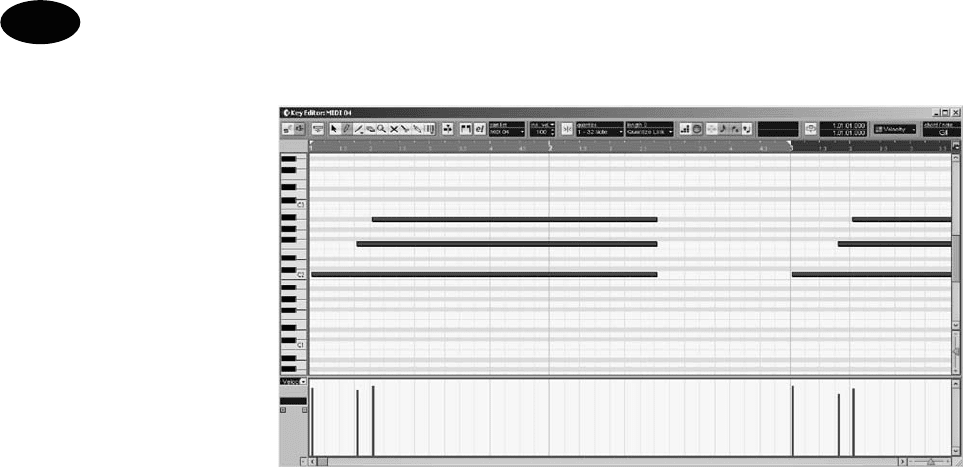
PART 2
Dance Genres
322
With the vocals in the track, it’s much easier to hear gaps in both frequency spec-
trum and arrangement, and these can be fi lled out with the lead instrumentation.
As already mentioned, lead instrumentation very rarely includes complicated riffs
so as not to draw attention, but simply adds to the atmosphere of the music. As a
result, in the majority of tracks leads consist of single hits at the beginning of the
bar or extremely simple melodies which appear as though they’ve been played
ad-lib over the chords and vocals. The old adage of ‘less is more ’ is certainly the
case with most trip-hop. Fundamentally, these tend to be played with real rather
than synthetic instruments and a proportionate amount of tracks will use clavi-
nets, organs, horns, theremins or fl utes but more commonly Rhodes pianos and
electric guitars that are treated heavily to tremolo effects (i.e. pitch modulation),
phasing, fl anging, distortion and a whole host of effects. In actual fact, as these
leads play such simple riffs it’s the effects applied that add to the atmosphere of
the music and so experimentation is the key ( Figure 16.4 ).
Most artists rely on guitar pedals to produce most of the effects and ideally,
it’s wise to follow suit. Since these are essentially produced to be used live on
stage, they don’t have a particularly low noise fl oor, so not only are they pow-
erful effects, they’re also pretty noisy. You can pick up guitar pedals new for
around £50 and they can change hands for as little as £20 on the used mar-
ket. Generally, you’ll need tremolo, fl anger, reverb and delay pedals to begin
with, as these are all suited and used in the production of the genre. You can,
of course, use digital or plug-in effects units in their place, but these tend to be
too clean so you’ll need to grunge them up a little.
Due to the sparseness of trip-hop, delay is the most commonly used of these
effects. This can be subsequently soiled by sending the audio out to a delay
unit set to a high feedback and sampling the subsequent delays. Once you have
these, import them into a separate track in an audio sequencer and, using a
mix of EQ and distortion, automate the EQ to gradually remove both the high
and low frequencies on each delay while increasing the distortion applied to
FIGURE 16.4
A typical Rhodes piano
lick
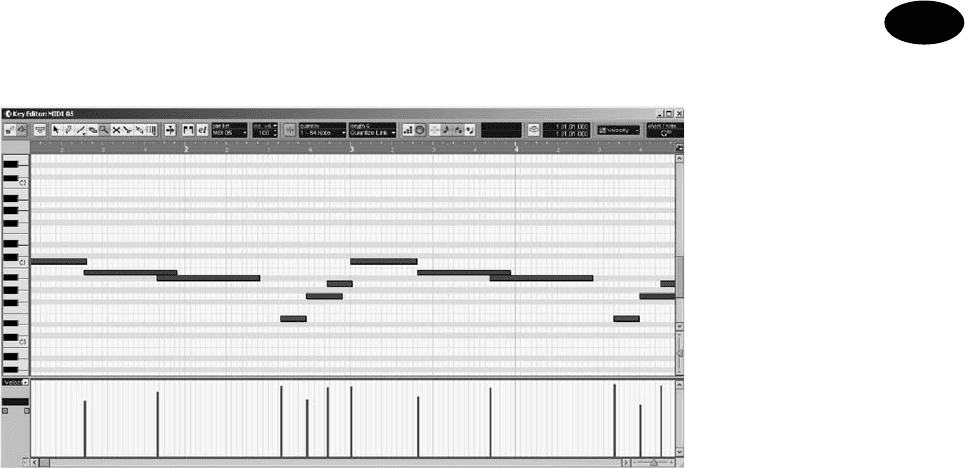
Trip-Hop
CHAPTER 16
323
each. Export this as another audio fi le and then use the scissors tool (or simi-
lar) to cut up the delays and place them where required in the arrangement.
If the sequencer does not allow automation (or you’re using hardware), you
can simply record the EQ and distortion tweaks to audio cassette (or DAT) and
then edit the results in the sequencer.
The fi nal element of trip-hop is the bass, but before proceeding any further it
should be noted that not all tracks will feature a bass line, and many that do
will use an upright bass that can also act as a lead instrument. Trip-hop is a
descendant of hip-hop mixed with elements of jazz and ambient, and as such
it is totally unnecessary to fi ll up the entire frequency spectrum and arrange-
ment with sounds. In fact, the relatively large spaces that are left between
instruments help in creating the all-important atmosphere of the music. This is
important to keep in mind when writing the bass since it can be quite easy to
get carried away and produce a bass with far too much movement.
Fundamentally, trip-hop draws the basses from dub, so on the whole basses are
kept relatively simple as they merely act as the underpinning of the track and
should not form a major melodic element in themselves. This is mainly to prevent
the bass from drawing attention away from the vocals. Consequently, a bass line
will often consist of nothing more than a few 1/8th or perhaps 1/4th notes per bar
that will tend to stay at one pitch or move by no more than 3, 5 or 7 semitones.
Simplicity is the solution here. More importantly, since the bass is often played
live, when programmed in MIDI, the notes should very rarely occur at the begin-
ning of each bar. It’s much more natural for the bass to begin just a few ticks before
or after to offset it from the rest of the record. This not only emulates the nuances
of a real bassist but it also makes the drums appear to pull or push the record for-
ward, helping to create a more fl owing groove. Creating this relationship can form
an essential part of the music but whether to sit it before or after the beat is entirely
open to artistic license. After programming it’s worth experimenting by moving it
before or after the beat to see which produces the best results ( Figure 16.5 ).
FIGURE 16.5
A typical trip-hop bass
rhythm
